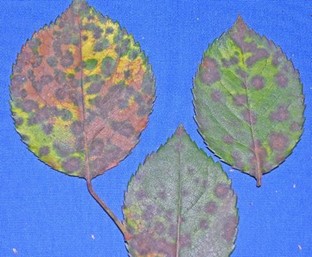Disease Notes
Contact
Plant Diagnostician
Phone: (479) 575-2727
Email: ssmith@uada.edu
Jason Pavel
Diagnostician
Phone: (479) 575-7257
Email: jpavel@uada.edu
University of Arkansas System Division of Agriculture
Cralley Warren Building
Room 16
2601 N. Young Ave.
Fayetteville, AR 72704
Rose - Black spot
by Sherrie Smith and Jason Pavel

Rose Black Spot-Diplocarpon rosae
Photo by Sherrie Smith, University of Arkansas Cooperative Extension
Black spot of roses is the most persistent and frustrating disease associated with growing roses. Black spot, caused by Diplocarpon rosae, was first introduced into the genome of modern roses by crossing Rosa foetida and Rosa foetida 'Persiana' roses with European roses. Prior to that time, the true yellow was unknown in European and American roses. Unfortunately, the gene for yellow coloring in Rosa foetida and the variety Rosa foetida 'Persiana' roses was strongly linked to susceptibility to Black spot. That susceptibility has, unfortunately, been passed on to many of our favorite modern roses.
Symptoms are circular to irregularly shaped black spots with feathery edges. Small black pimples, (acervuli), may be seen on the lesions. The leaf tissue surrounding the spots turns yellow, eventually causing infected leaves to fall from the plant prematurely. Badly affected plants will have virtually no leaves. Roses will replace the fallen leaves, but repeated defoliation weakens the plant, as well as being unsightly.
There are some excellent cultivars with resistance to Black spot. Unfortunately, many with good resistance to the disease lack the wonderful fragrance commonly associated with roses. For those unable to locate cultivars with both disease resistance and good scent, Black spot can be managed with a good spray program coupled with cultural controls.
Overhead irrigation should be avoided if possible. If overhead irrigation is used, it should be done in the morning so foliage can dry quickly. Fallen leaves should be raked up and removed from the planting. Susceptible roses should be sprayed with a rose fungicide as soon as they leaf out in the spring, and then every 7-10 days, especially after a rain. For those, who dislike spraying weekly, a systemic such as Bio Advanced Disease Control for Roses, Flower, & Shrubs is available. Now is the time to start spraying!
Take aways
- Begin spraying as soon as roses put on new growth in the spring.
- Clean up all fallen leaves.
- Avoid overhead irrigation.
- Choose resistant cultivars.
This work is supported by the Crop Protection and Pest Management Program [grant no. 2017-70006- 27279/project accession no. 1013890] from the USDA National Institute of Food and Agriculture.